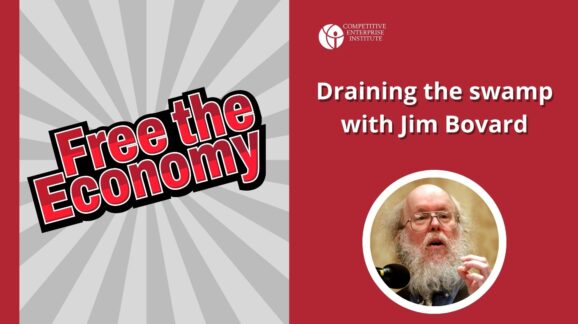There are two main areas in which Congress can enact meaningful reform. The first is to rein in regulatory guidance documents, which we refer to as “regulatory dark matter,” whereby agencies regulate through Federal Register notices, guidance documents, and other means outside standard rulemaking procedure. The second is to enact a series of reforms to increase agency transparency and accountability of all regulation and guidance. These include annual regulatory report cards for rulemaking agencies and regulatory cost estimates from the Office of Management and Budget for more than just a small subset of rules.
In 2019, President Trump signed two executive orders aimed at stopping the practice of agencies using guidance documents to effectively implement policy without going through the legally required notice and comment process.
Featured Posts

Blog
Free the Economy podcast: Draining the swamp with Jim Bovard
In this week’s episode we cover fake endangered species, Pennsylvania’s climate policy showdown, a robust defense of property rights in New…

Blog
This week in ridiculous regulations: Seat belts and eagle possession
This week’s roundup will be a little different than usual. Since the new year began mid-week, and I already published a breakdown of 2024’s year-end numbers, as…

Blog
Biden’s regulatory landscape: A year-end analysis
As we ring in 2025, the Federal Register reveals a noteworthy chapter in regulatory history under the Joe Biden administration. We take our traditional year-end look at it here. The 2024 Federal Register closed…
Search Posts
Products
Liberate to Stimulate
Download Chapter 10 as a PDF Policy makers frequently propose spending stimulus to grow or strengthen economies. That was certainly the case in the…
Products
Another Dimension of Regulatory Dark Matter: Over 22,000 Public Notices Annually
Download Chapter 7 as a PDF Without actually passing a law, government can signal expectations and influence various industries—including health care, retirement, education, energy…
Products
What Comes after “Trillion”? The Unknowable Costs of Regulation and Intervention
Download Chapter 4 as a PDF If real debt levels on the fiscal budget and entitlements can be vastly higher than the public is…
Products
Swamp Things—Trump’s Discordant Regulatory Impulses Offset His Deregulatory Successes and Expanded the Administrative State
Download Chapter 2 as a PDF President Trump attempted to prune rules and costs and held down regulatory output with more enthusiasm than other…
Products
The Presidential Dimension of Regulatory Dark Matter: Executive Orders and Memoranda
Download Chapter 6 as a PDF Executive orders, presidential memoranda, and other executive actions make up a large component of executive “lawmaking.” They merit…
Products
Toward a Federal “Regulatory Budget”
Download Chapter 3 as a PDF When Congress spends, no one questions that disclosure is necessary for voters to hold representatives accountable. Federal expenditure…
Staff & Scholars

Clyde Wayne Crews
Fred L. Smith Fellow in Regulatory Studies
- Business and Government
- Consumer Freedom
- Deregulation

Ryan Young
Senior Economist
- Antitrust
- Business and Government
- Regulatory Reform

Fred L. Smith, Jr.
Founder; Chairman Emeritus
- Automobiles and Roads
- Aviation
- Business and Government

Sam Kazman
Counsel Emeritus
- Antitrust
- Automobiles and Roads
- Banking and Finance

Marlo Lewis, Jr.
Senior Fellow
- Climate
- Energy
- Energy and Environment